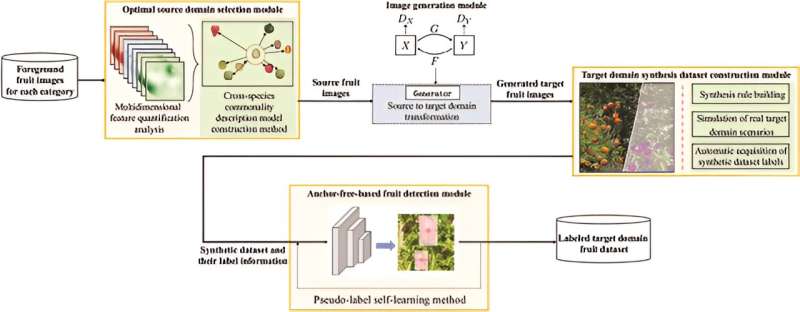This article has been reviewed according to Science X's editorial process and policies. Editors have highlighted the following attributes while ensuring the content's credibility:
fact-checked
trusted source
proofread
Reforming agricultural AI: EasyDAM_V3 unveils next-gen automatic fruit labeling

In the dynamic realm of agricultural AI, deep learning-based fruit detection has gained prominence, particularly in smart orchards. These techniques, however, heavily depend on large, manually labeled datasets, a process both time-consuming and labor-intensive.
The previous work introduced a generative adversarial network (GAN) method, EasyDAM, to mitigate labeling costs by generating simulated fruit images. Nonetheless, this approach faces challenges: firstly, it lacks adaptability across diverse fruit species, leading to performance fluctuations in varying orchard environments.
Secondly, while it reduces labor in the target domain, it still necessitates manual labeling in the source domain, not fully eliminating manual processes. There exists a critical to develop methods for selecting optimal source domain datasets and achieving truly automated labeling, addressing these current limitations and advancing towards zero-cost automated label generation.
In July 2023, Plant Phenomics published a research article titled "EasyDAM_V3: Automatic fruit labeling based on optimal source domain selection and data synthesis via a knowledge graph."
In an endeavor to advance automatic fruit labeling with high efficiency and zero cost, this study introduces EasyDAM_V3, a novel approach that combines optimal source domain selection with synthetic dataset generation. EasyDAM_V3 aims to address two primary challenges: selecting the most suitable source domain fruit datasets for image translation and minimizing the manual annotation cost in the target domain.
The first aspect of EasyDAM_V3 involves a systematic selection of source and target domain datasets for image translation models. This process utilizes a multidimensional spatial feature model, enabling the identification of the most appropriate source domain dataset that can correspond to multiple target domain fruits. The selection is based on analyzing phenotypic features like shape, color, and texture across various fruit datasets.
For instance, in the study, pears were identified as the optimal source domain for translating images to target domains like citrus, apples, and tomatoes. This determination was made through a clustering algorithm and multidimensional feature space analysis, ensuring a higher fidelity in translation generalization. The second aspect focuses on constructing a knowledge graph to generate synthetic datasets with accurate label information.
EasyDAM_V3 employs transparent background fruit image translation and an anchor-free detector for pseudo-label self-learning. This innovative approach can handle fruits of different scales and shapes, enhancing the final label generation accuracy.
The experimental validation of EasyDAM_V3 involved citrus, apple, and tomato as the target domains. The process comprised three main parts: employing multidimensional feature quantization and spatial reconstruction to select the optimal source domain fruit, inputting these source fruits into the CycleGAN model for target domain image generation, and utilizing these images to construct synthetic datasets.
These datasets were then used to train an anchor-free detector-based fruit detection model. Results from these experiments showed that EasyDAM_V3 could successfully translate and generate labels for the target domains using pears as the source domain, with high average precision rates of around 90%. This demonstrates EasyDAM_V3's effectiveness in addressing both challenges of optimal source domain selection and reducing manual annotation costs.
In summary, the approach outlined by EasyDAM_V3 not only improves the applicability and domain adaptability of automatic labeling algorithms but also represents a significant step towards achieving efficient, cost-effective solutions in agricultural AI and smart orchard management.
More information: Wenli Zhang et al, EasyDAM_V3: Automatic Fruit Labeling Based on Optimal Source Domain Selection and Data Synthesis via a Knowledge Graph, Plant Phenomics (2023). DOI: 10.34133/plantphenomics.0067
Provided by NanJing Agricultural University





















